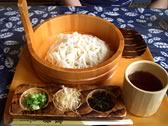|

|
 |
 |
 |
 |
 |
 |
 |
 |
| left: Inaniwa udon('udon' means 'Japanese wheat noodle'). This is a basic way of serving udon., boil udon and rinse in water, and place on a bowl. You eat udon in a dipping sauce before eating. Inaniwa udon is one of the three famous udons in Japan, Sanuki udon(a local specialty in Kagawa) and Kishimen(a local specialty in Nagoya). People say that Inaniwa udon has a proud history of more than 300 years in Inaniwa, which is the region of Akita prefecture. Inaniwa udon is a local specialty in Inaniwa!
center: Hinaijidori Oyako-don('oyako' means 'parent and child'). Oyako-don is a bowl of rice topped with chicken and eggs. The name of the dish is both chicken and egg and they are used in the same dish. Oyako-don is one of the common donburis(rice bowl dish) in Japan. when beef is used, it is called 'Tanin-don'('tanin' means 'not blood relations'). This Hinaijidori Oyako-don is used 'Hinaijidori' as a parent, which is a type of chicken meat and it is well-known for its good taste. Because I guessed that an egg of Hinaijidori wasn't actually used in it, I thought that it wasn't 'Oyako-don' for real!
right: Cold Inaniwa udon. This is not a typical way of serving udon. However, I think that it is a good way to eat udon in summer. There were many ingredients for the topping, wild vegetables, Japanese radish, chopped green onions, dried laver seaweed, tororokonbu(kelp flakes), umeboshi(pickled Japanese apricot), natto(fermented soybeans) and so on.
By the way, I hadn't grown up eating natto. So I wasn't able to eat natto untill recently because of its terrible smell and gooey texture. However, a famous TV program last year, had praised natto's beauty benefit other than well-known health benefits. It had reported that some component of natto had the effect of rejuvenation. So I forced myself to eat natto most days of the week. It wasn't easy work! Because of my effort I finally got to like natto. I used to turn green when I took one bite of natto.... Now I love natto and I become like Japanese! There is more to it... the effect of rejuvenation in the TV program was later found to be fake! |
|
 |
|
|
 |